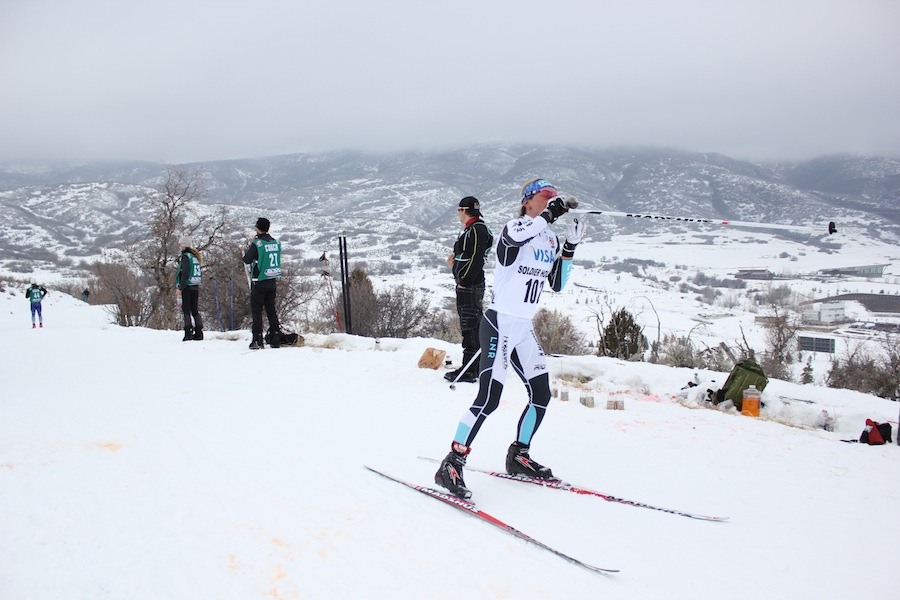
What’s the best strategy for feeds in a ski marathon? How many carbohydrates do you need, and how often?
That’s the question asked by a team of researchers from Mid Sweden University in Östersund and the University of Bath in Great Britain. With a group of experienced, but not elite, adult ski racers, they investigated high and low carbohydrate feeds delivered at high or low frequency over the course of several 30 k rollerski time trials on a treadmill.
The results were recently published in the Scandinavian Journal of Medicine and Science and Sports. While the skiers did not perform differently under the various feeding regimes, a number of physiological variables did change.
“The take-away message I would give to athletes, from this study, is to understand how nutrition can affect metabolism,” lead author Ben Stocks wrote in an email. “There are certain metabolic things we want to see during endurance exercise… One of those is maintenance of normal blood sugar levels and this study would suggest that, on average, drinking smaller volumes of carbohydrate more regularly is beneficial in that regard. Additionally, the little and often approach appears to cause less discomfort than the larger drinks taken less often.”
The feeds were calculated to provide particular rates of carbohydrates per minute, with amounts calibrated to each athlete based on how long they took to ski between the set distances where feeds were delivered.

The high carbohydrate treatment delivered about double the rate of the low carbohydrate treatment. In the low frequency treatment only two feeds were given, while six were given in the high frequency treatment. This required also adjusting the amount in each feed, so that in the high frequency treatment athletes only received a third as much carbohydrate per drink.
The treadmill was slowed for the feeds as well as blood sampling, somewhat mimicking a downhill on the racecourse (although of course treadmills can’t go downhill). Each athlete did four time trials, one for each feeding regime, in a randomized order with at least four days in between.
The researchers found that with only two feeds, athletes could not maintain a normal, steady blood sugar level.
“This is important because glucose is transported from the blood into the muscles and forms a critical fuel during exercise performance,” Stocks wrote in his email. “We know from studies in other sports, such as cycling, that a reduction in blood sugar levels is related to the onset of fatigue and, therefore, an inability to continue exercising at the same intensity. Maintaining blood sugar levels is therefore a crucial strategy to maximising performance in endurance sports.”

They also found that athletes experienced greater gastrointestinal discomfort when consuming a lot of carbohydrates but only infrequently.
However, performance did not improve under any particular feeding regime. Instead, times to complete the 30 k test improved with each successive time trial, no matter what order the treatments were completed.
“Increased gastrointestinal discomfort is not going to improve performance and, anecdotally, will negatively affect performance in some individuals,” Stocks wrote. “Therefore, in the absence of any obvious performance effects, increased gastrointestinal discomfort and poorer maintenance of blood sugar levels suggest to us that low frequency carbohydrate drinking should not be a recommended strategy.”
As for the amount of carbohydrate delivered, there didn’t appear to be major differences in physiological variables between the high-carb and low-carb feeding treatments when both were delivered six times over the course of the time trial. Frequency seemed to be more important than amount.
One suggestion in the paper was that after a baseline carbohydrate ingestion rate of 1 to 1.3 grams per minute, adding more and more carbs doesn’t give much benefit, at least over the 30 k distance. In a longer race, that may change as the body would be forced to dip into and deplete glycogen stores.
While the results seem to be clearcut that frequent feeds provide for a better race experience, if not necessarily better performance, Stocks cautioned that the real takeaway message was to get to know your body.
“It is important to stress that every individual responds differently to these things and that it is important to work out for yourself how different nutritional approaches affect you,” he wrote. “While it may be difficult to measure blood glucose without visiting a specialist sports science centre, your feelings of gastrointestinal discomfort are easy monitor, as is your performance and that is the ultimate goal. Get to know what works best for you.”
Chelsea Little
Chelsea Little is FasterSkier's Editor-At-Large. A former racer at Ford Sayre, Dartmouth College and the Craftsbury Green Racing Project, she is a PhD candidate in aquatic ecology in the @Altermatt_lab at Eawag, the Swiss Federal Institute of Aquatic Science and Technology in Zurich, Switzerland. You can follow her on twitter @ChelskiLittle.



